#Herero
Text
Is Germany’s other genocide being forgotten? | The Listening Post
youtube

#germany#europe#namibia#history#genocide#no pride in genocide#herero#nama#class war#oppression#oppressor#free all oppressed peoples#pedagogy of the oppressed#oppressive#repression#ausgov#politas#auspol#tasgov#taspol#australia#fuck neoliberals#neoliberal capitalism#anthony albanese#albanese government#colonialism#colonial violence#colonial america#colonization#colonizers
11 notes
·
View notes
Text
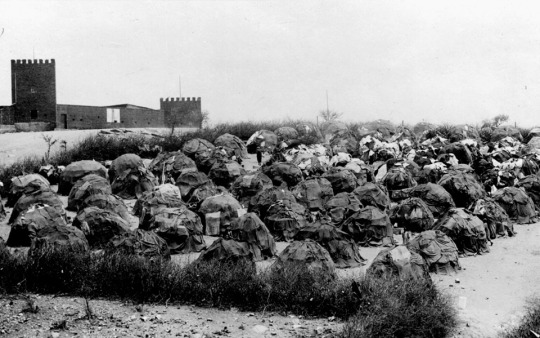
«The largest of the concentration camps, beside the German fort in the capital Windhoek. At its height, this camp held 7,000 prisoners.» (detail), in David Olusoga and Casper W. Erichsen, (2010), The Kaiser's Holocaust. Germany’s Forgotten Genocide and the Colonial Roots of Nazism, Faber and Faber, London, 2011
#graphic design#photography#book#david olusoga#casper w. erichsen#herero#ovaherero#faber and faber#2010s
17 notes
·
View notes
Text
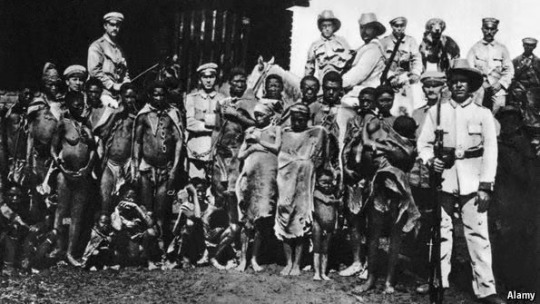

The German missionaries began working in Southern Africa in the late 1820s and experienced significant success in evangelizing and educating their converts.
But toward the end of the 19th century, a new gospel' was increasingly introduced to Africa. Germans, many indoctrinated in Social Darwinian ideas, colonized South West Africa (Namibia today) in the 1880s.
They generally regarded the Herero people as primitive and frequently referred to them as 'subhuman' and 'baboons!' The very first genocide of the 20th century occurred in Namibia perpetrated by Germans on the Herero and Nama people in concentration camps.
The body parts of these dead prisoners were used in racial studies trying to prove the inferiority of blacks. Before the skulls were sent off and sold to German universities, the female prisoners (Herero Women) did all the horrendous preparatory work.
Eugen Fischer, a geneticist and avid eugenicist, was sent to Namibia for one main purpose--to evaluate the physical characteristics and intelligence of several hundred interracial children and prove that interracial relations would be detrimental to European culture. It was Fischer's work that led to the victimization and sterilization of blacks (and other groups) in the Third Reich.
They also perpetrated inhumane acts toward the Herero: they progressively seized their land and cattle, shot people for no reason at all, sexually abused and raped the women and because of their interest in evolutionary theory and missing links they dug up the graves of the Herero's ancestors and stole their skulls. Not surprisingly, localized reactions to this from the Herero led to efforts to drive the Germans out of their land.
•••
Los misioneros alemanes comenzaron a trabajar en el sur de África a fines de la década de 1820 y experimentaron éxito significativo en la evangelización y educación de los convertidos.
Pero a fines del siglo XIX, un nuevo evangelio se estaba introduciendo cada vez más en África. Los alemanes, muchos de ellos adoctrinados en ideas sociales Darwinianas, colonizaron el suroeste de África (hoy conocida como Namibia) en la década de 1880.
Generalmente, consideraban que los Herero eran personas primitivas y frecuentemente les llamaban “infrahumanos” o “babuinos”. El primer genocidio del siglo XX ocurrió en Namibia, perpetrado por los alemanes en campos de concentración hacia las personas Herero y Nama.
Las partes del cuerpo de estos prisioneros muertos eran utilizados en estudios raciales que trataban de demostrar la inferioridad de los negros. Antes de que los cráneos pudiesen ser enviados y vendidos a universidades alemanas, las mujeres prisioneras (Herero) tenían que hacer un trabajo de preparación horrendo.
Eugen Fischer, un genetista y ávido eugenista, fue enviado a Namibia con el propósito principal de evaluar las características físicas y la inteligencia de cientos de niños interraciales y demostrar que las relaciones interraciales serían perjudiciales para la cultura europea. Fue el trabajo de Fischer el que condujo a la victimización y esterilización de los negros (y otros grupos) durante el Tercer Reich.
También perpetraron actos inhumanos hacia los Herero: se apoderaron progresivamente de sus tierras y ganado, disparaban sin motivo alguno, abusaron sexualmente y violaron a las mujeres y por su interés en la teoría evolutiva y los eslabones perdidos excavaron las tumbas de los antepasados de los Herero y robaron sus cráneos. No es sorprendente que las reacciones localizadas de los Herero a esto condujeran a los esfuerzos para expulsar a los alemanes de su tierra.
#blacklivesmatter#blacklivesalwaysmatter#english#spanish#blackhistory#history#share#read#blackhistorymonth#blackpeoplematter#namibia#genocide#Herero#knowyourhistory#follow#historyfacts#blackbloggers#blackownedandoperated#blackhistoryyear#black history is american history#african history#black history is world history#black history is everybody's history#black history 2023#black history month#black history matters#black history#germany#africanhistory365#africanhistory
25 notes
·
View notes
Text

The Herero and Namaqua Genocide : Photograph showing German forces gathered in GSWA to join in the conflict against the herero people in 1904.
The Herero and Namaqua Genocide was the massacre of approximately 50,000 – 65,000 Herero and 10,000 Nama between 1904 and 1907 by German military forces in German South West Africa (GSWA) – modern-day Namibia.
Background
Germany formally colonised GSWA in 1884. Prior to colonisation , several distinct native groups lived freely in the area, including the Herero, the Nama, the Damara, the San, and the Ovambo. Under German rule, many of these native groups were used as slave labour and had their land confiscated and their cattle stolen. As a result of this treatment, tensions between the native population and the ruling Germans continued to rise.
Uprising
In January 1904, the Herero population, led by Chief Samuel Maharero, carried out a large armed rebellion against the oppressive German colonial rule. The German ruling forces were unprepared for the attack and approximately 123 German colonial settlers were killed by the Herero. Over the following months, however, the Herero were slowly overwhelmed by the more modern, well-equipped German force under the command of Major Theodor Leutwin. By June 1904, Major Leutwin had cornered the Herero forces at the Waterberg Plateau and was attempting to negotiate their surrender.
The German government in Berlin were frustrated by Leutwin’s slow progress in dissipating the uprising, and in May 1904 appointed Lieutenant General Lothar von Trotha Supreme Commander of GSWA. Trotha arrived in GSWA on 11 June 1904.
Genocide
On 11 August 1904, Trotha abandoned negotiations for a surrender and attempted an aggressive encirclement tactic, surrounding the Herero at the Battle of Waterberg and killing between 3,000 – 5,000 Herero combatants. Yet, despite the brutal tactics of the Germans, most of the Herero managed to escape into the Omaheke desert.
Under Trotha’s command, the Schutztruppe ruthlessly pursued the thousands of Herero men, women and children who were attempting to cross the desert to reach to British Protectorate of Bechuanaland (modern-day Botswana). Thousands of Herero died from being shot to death, drinking water from poisoned wells, or from thirst and starvation in the desert.
On 2 October 1904, Trotha escalated the violence against the Herero in an order: ‘Within the German borders, every male Herero, armed or unarmed […] will be shot to death. I will no longer take in women or children but will drive them back to their people or have them fired at. These are my words to the Herero people. [From] The great general of the mighty German Kaiser’ [Katharina von Hammerstein, ‘The Herero: Witnessing Germany’s “Other Genocide”’, Contemporary French and Francophone Studies 2016, 20:2, 267-286, 276].
In November 1904, the German government in Berlin overturned General Trotha’s inhumane execution order, and instead commanded that the surviving members of the Herero population be incarcerated in concentration camps, such as the Shark Island Concentration Camp . By this point, however, many thousands of Herero had already been murdered.
The remaining Herero who were incarcerated in the concentration camps were subjected to lethal conditions (with a mortality rate of 47-74%), and prisoners endured poor hygiene, little food, forced labour and medical experiments.
In 1905, the Nama people in the south also rose up against the German rule and engaged the colonisers in guerrilla warfare for the following two years. Any Nama that were caught by the Germans were executed or incarcerated in the same concentration camps as the Herero, with extremely high mortality rates.
In total, by the end of the conflict on 31 March 1907, approximately 50,000 – 65,000 Herero and 10,000 Nama had been murdered by the German ruling forces.
#namibia#germany#genocide#black history#world history#history#The Herero and Namaqua Genocide#Herero#artwork#holocaust#Auschwitz#freedom#free gaza#فلسطين#تمبلر#united nations#UNRWA#FUNNY#LOL#ART#artist#tumblr#MEME#HUMOR
5 notes
·
View notes
Text

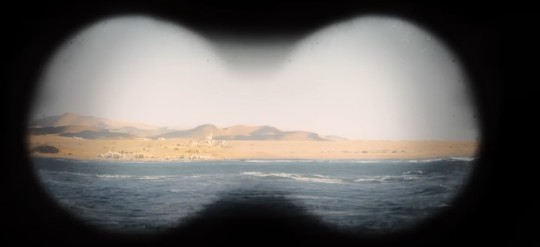
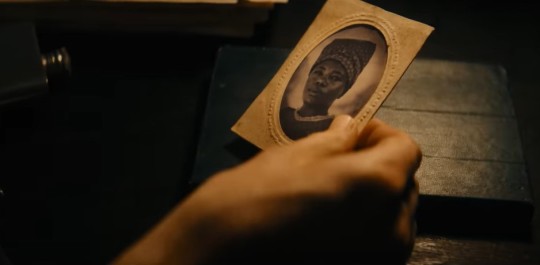

Der vermessene Mensch (2023) - Lars Kraume
Sie werden sehr viele schöne Dinge zurücklassen auf ihrer Flucht.
#der vermessene mensch#measures of men#lars kraume#Girley Charlene Jazama#Leonard Scheicher#film#herero#nama#colonialism#german film#film still#watched on the flight STL FRA#watched in december 2023#german colonialism
5 notes
·
View notes
Text

The Ohorokava is a beautiful symbol of the never ending perseverance of indigenous people against colonial rule!👗
🐮🇳🇦🐮
#history#ohorokava#herero#otjikaiva#traditional dress#fashion history#indigenous people#namibia#african women#femininity#dress#resistance#black girl magic#womens history#girly things#colonization#stylish#african femininity#german empire#traditional fashion#african history#protest#clothing#black femininity#namibian history#nickys facts
12 notes
·
View notes
Text
And this is precisely why Namibia entered the chat. Y'all come see this audacity. 🤬
#namibia#german occupation of namibia#give the namibians their land back#yes it's theirs#german colonialism#no wonder they support isn'treal#all colonizers need to go#never forget#know your history#namibian genocide#herero#nama
2 notes
·
View notes
Text
Also reminder that germany acknowledged the genocide against the Herero and Nama people only in 2021, 117 years after they started it and they haven't compensated Namibia in any way yet
2 notes
·
View notes
Text
A Movie Confronts Germany’s Other Genocide
“Measures of Men” tells the story of the systematic massacre of Herero and Nama people in what is now Namibia. Its maker hopes the film will bring a debate about Germany’s colonial guilt into the center of society.

Leonard Scheicher, left, and Girley Jazama in “Measures of Men,” which tells the story of the Herero and Nama genocide in what now Namibia through the eyes of a German anthropologist.Credit...Julia Terjung/Studiocanal GmbH
By Thomas Rogers
Reporting from Berlin
March 31, 2023
Germany is often praised for its willingness to confront the darkest moments of its history, but in recent years, activists have pointed to a blank spot in the country’s culture of remembrance. Decades before the Holocaust, Germany perpetrated the 20th century’s first genocide: From 1904 to 1908, German colonial officials systematically killed tens of thousands of Herero and Nama people in what is now Namibia. This atrocity is little known outside academic circles, and there are few memorials or pop cultural depictions of those events.
Now, a new movie, “Measures of Men,” aims to change that and bring a debate about Germany’s colonial guilt into the center of society. The glossy film, directed by the German filmmaker Lars Kraume, tells the story of the killings through the eyes of a German anthropologist. Aside from playing in movie theaters, where it opened last week, “Measures of Men” had a special screening for lawmakers in Germany’s Parliament, and was the focal point for a series of events at the Humboldt Forum, a central Berlin museum housing ethnological items. Its distributor, Studiocanal, said in a statement that it was planning to show the film in school and educational contexts.
“Measures of Men” has also prompted a new discussion in the German media about what many see as Germany’s sluggish attempts to come to terms with its colonial past. In recent years, the country has moved to return numerous artworks acquired during the colonial period, but the process of ratifying a reconciliation agreement between Namibia and Germany has stalled, and thousands of African human remains, transported to Germany from its colonies, remain in institutional collections.
In an interview in Berlin, Kraume, 50, explained that his movie was partly inspired by the 1978 NBC mini-series “Holocaust,” an early fictionalized TV depiction of the Shoah, which played a key role in spreading awareness of German guilt after it was broadcast here. “You have the possibility through cinematic storytelling to reach an audience that doesn’t engage so much with history books,” he said, adding that he hoped his film would be the first of many, much in the way “Holocaust” paved the way for films like “Schindler’s List.”

Lars Kraume, who directed “Measures of Men,” said, “You have the possibility through cinematic storytelling to reach an audience that doesn’t engage so much with history books.”Credit...Gordon Welters for The New York Times
“Measures of Men,” which was filmed in Berlin and Namibia, focuses on an ambitious German ethnologist (Leonard Scheicher) who develops a fascination with a Herero woman (Girley Jazama) after measuring her cranial features as part of his research. His fixation leads him to travel to German South West Africa (now Namibia), where he witnesses and eventually become complicit in the colonial slaughter.
“It’s not just a film about the genocide,” Kraume said, “but also about ethnologists who want to explore foreign cultures, but destroy them.”
Many of the scenes were based on real events of the genocide, which took place during a conflict between Germans and Africans known as the Herero and Nama War. After thousands of Herero men, women and children fled into the Omaheke Desert in 1904 to escape the fighting, German troops sealed off its edges and occupied the territory’s water holes, leading many to die of thirst. Lothar von Trotha, the governor of the colony, then issued a proclamation calling for all remaining Herero to be killed.
After the Nama joined the fight against the German colonizers, they were also targeted, and colonial officials set up concentration camps, ostensibly to provide labor for German-owned businesses, in which hundreds of prisoners died. The film depicts real facilities in one such camp in which the decapitated heads of Herero and Nama were boiled and cleaned for export to German ethnological institutions. Thousands of skulls of unclear origin remain in German collections to this day.
Kraume long wrestled with how to tell the story as a European filmmaker, and said he had decided to depict it from a German perspective for fear that centering it on African protagonists would represent a form of “cultural appropriation.” At one point in the development, he hoped to structure it similarly to Hollywood films about the Vietnam War, such as “Platoon” and “Apocalypse Now,” that center their plots on conflicts between “good” and “bad” American soldiers. “But there were actually no good Germans,” Kraume said.

Girley Jazama, who plays the movie’s female lead, discovered that her great-grandmother has been born in a German-run concentration camp while researching to play the role.Credit...Gordon Welters for The New York Times
Jazama, an acclaimed Namibian actress who plays Kezia Kambazembi, the film’s lead female role, learned German to play her part. In preparation for the role, she spoke to relatives about her family’s connection to the genocide and discovered that her great-grandmother had been conceived in a German-run concentration camp. “My ancestors need to be at peace,” she said in an interview. “That’s why I became a part of this story.”
Jazama said that, though the film had largely been made to spur discussion in Germany, it had also been a talking point in Namibia, where the events of the genocide had often been passed down via family members. “A lot of people are grateful,” she said, recalling that one audience member had shared appreciation that “now there is a visual representation of what happened, versus just it being told orally.”
The reaction in Germany has been more mixed. Writing in the Frankfurter Allgemeine Zeitung newspaper, the critic Bert Rebhandl wrote that the film focused too much on “German self-understanding” while pushing African perspectives to its edges. A writer in the Süddeutsche Zeitung argued that the film depicts too little of the genocide to transmit the scope of the killing and it does not do “justice to the horror.”
Henning Melber, a political scientist who has written extensively about German colonialism, said that criticism of the film shouldn’t distract from its potential role in remedying what he described as Germany’s “colonial amnesia.” He said that the film “triggers a debate in a wider German public in a way that none of us academics can achieve.”
Kraume emphasized that, although “Measures of Men” was meant to appeal to a mass audience, it was an explicitly “political film,” and that its rollout was partly engineered to spur a discussion. He hoped the screening for lawmakers would drive politicians to work harder at compensating the Herero and Nama, he added.
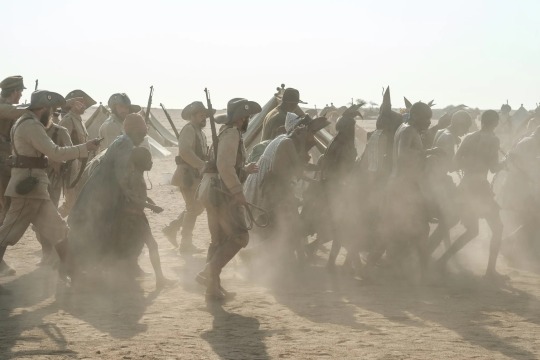
A scene from “Measures of Men.” In 1904, thousands of Herero people fled from German soldiers into the Omaheke Desert, where many died of thirst.Credit...Willem Vrey/Studiocanal GmbH
Although Namibian and German authorities agreed in 2021 on the terms of a reconciliation agreement, including around $1.1 billion in aid that Germany would pay over the next 30 years, the process has since come under fire from groups representing victims’ descendants, who argue that amount is too low, and say they were unfairly left out of the negotiation process. The Namibian government has since backtracked on plans to ratify the agreement, and the German authorities have resisted calls by the Namibians to reopen talks.
Kraume said Germany’s president, Frank-Walter Steinmeier, should travel to Namibia and officially apologize for the genocide, and that all human remains still held in Germany should be returned. “Europe has done far too little to reconcile with victims,” he said. “I think cinema allows us to awaken emotions, and implant images that can let you see events differently,” he said. “But this is only the beginning of the discussion.”
14 notes
·
View notes
Photo

Opuwo, 2022
#picoftheday#travel#namibia#africa#original photographers#photographers on tumblr#street photography#streetphoto color#blue aesthetic#street life#traditional clothes#herero#photooftheday
17 notes
·
View notes
Text
My greatest hope for 2023 (besides the tripledemic calming the fuck down)?
Consensual romance stories (hetero and lgbt+).
I’m SO SICK of these stalker, SAer, manipulative fucks
Bury em in the back with me, girlies, and let’s plant some mushrooms
#we all fucking know it’s horrible modelling for the youngins#which makes them compliant in Su’s relationships and takes years to learn and accept what happened#I’m not saying we’re responsible for their sex education. that’s mostly on their parents and school#BUT. NOT propping up these despicable stories/characters is a fucking start#I take no criticism at this time. there’s no reason we shouldn’t have HEALTHY and CONSENSUAL relationships propped up to the same if not#more of a degree as all these other things#2023#consensual relationships#Herero#lgbt
8 notes
·
View notes
Text

David Olusoga, Germany comes to terms with its forgotten Namibian death camps, "Decades before the Nazis, thousands of men, women and children were exterminated on the direct orders of the leadership in Berlin", «The Guardian», January 15, 2017
(image)
«Der Herero-Krieg als Lehrstück.
Die einzelnen Gefechte der deutschen Schutztruppen mit den Herero wurden ausführlich kommentiert und graphisch skizziert, wie hier das Gefecht bei Klein Barmen am 4. März 1904.»
– Der Krieg gegen die Herero 1904, Bundesarchiv, Coblenza
#history#historiography#map#newspaper#david olusoga#herero#ovaherero#the guardian#bundesarchiv#1900s#2010s
11 notes
·
View notes
Text



Der vermessene Mensch (2023) - Lars Kraume
Ureinwohner verschwinden wie der Schnee in der Sonne der aufgehenden Zivilisation.
#der vermessene mensch#measures of men#lars kraume#film#film still#quote#colonialism#herero#nama#german film#german colonialism
1 note
·
View note
Text
youtube
Top 40 Tuesday - Recently Released in Namibia | Blossom - Ombili Nee (Gimme Some Love) (what language is this?)
#soft afropop#herero?#top 40 tuesday#blossom#ombili nee#gimme some love#what language is this#probably:#bantu#nigercongo#africa#namibia#herero#2023#2020s#pop#Youtube
0 notes
Text
"The first genocide of the 20th century", complete with concetration camps and medical experiments. If Germans can do one thing...
To add insult to injury, this genocide isn't taught in schools. Most Germans don't know about this. Heck, most believe Germany never had colonies or enslaved people. And even less care. I think a lot of people learned of the Herero from a "satire" show (more investigative journalism, similar to Last Week Tonight)
youtube
0 notes